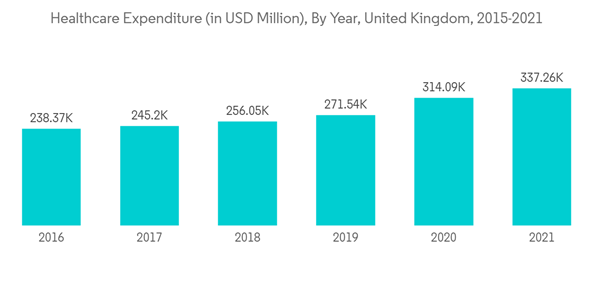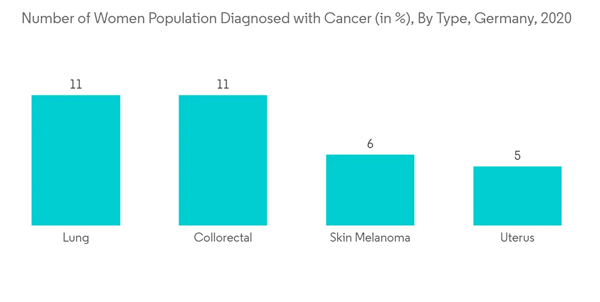The COVID-19 pandemic affected healthcare systems in Europe and resulted in the interruption of usual care in many healthcare facilities. The pandemic posed several difficulties for medical device manufacturers and supply chains during the very initial phase of the pandemic. But with the increasing cases of COVID-19 infection, the demand for X-ray devices increased, especially for chest X-ray devices. An article published in JMRS in February 2022 stated that the utilization of chest X-rays increased during the pandemic due to increased cases of co-infection among the target population. Thus, the increased risk of heart disease among COVID-19 patients and the exponentially high number of COVID-19 in Europe increased the demand for portable X-ray devices. Hence, the pandemic considerably impacted the market studied.
Factors such as the growing geriatric population, the increasing prevalence of vascular diseases, and advancements in technology are major contributors to the growth of the market studied.
Aging is associated with most illnesses, such as hypertension, diabetes, cardiovascular diseases (CVDs), and other orthopedic ailments. Most of these are chronic diseases that require proper treatment and diagnosis. Thus, with the increase in the geriatric population, the demand for X-ray devices is increasing. The incidence of the older population aged 65 years and older was 17.78, 12.24, 13.76, and 13.16 (in millions) in Germany, the United Kingdom, Italy, and France, respectively, as per the data updated by the PRB organization in 2022. Such numbers show a high burden on the geriatric population in Europe. As portable X-rays provide better results than most conventional X-rays without moving the patients from one place to another, the demand for such devices has been increasing recently. This is expected to contribute to the growth of the market studied over the forecast period.
Moreover, technological advancements and recent developments in the market are anticipated to drive the growth of the market. For instance, in May 2021, Fujifilm revealed the results of Europe's first real-world trial of the FDR Xair portable X-ray system in community care. The trial was conducted in collaboration with the Fujifilm United Kingdom, Northumbria Healthcare, the National Health Services (NHS) Foundation Trust, and the Northeast Ambulance Service NHS Foundation Trust and significantly reduced hospitalizations. Such advancements are contributing to market growth.
Therefore, due to the above-mentioned factors, the market studied is expected to grow significantly during the study period. However, the risk of radiation exposure associated with the procedures is expected to restrain the market growth over the forecast period.
Europe Portable X-ray Devices Market Trends
Digital X-ray Segment is Expected to Witness Significant Market Growth
Digital X-rays expose approximately 70%-80% less radiation than conventional X-rays. This is hugely beneficial for the long-term health of patients, especially pregnant women or patients who are already suffering from long-term illnesses, to ensure safety. With the help of digital X-rays, dentists can now easily recognize oral issues, which is leading to a declining need for an invasive investigation at the diagnosis stage. Additionally, digital radiography safely stores patient X-rays, resulting in no loss from the holders. Hence, the segment is anticipated to witness growth over the forecast period.Digital X-ray systems directly convert the transmitted X-ray radiation into a digital image using an array of solid-state detectors such as amorphous selenium or silicon and display the image directly on the computer. While conventional film X-rays are still helpful in making diagnoses, digital X-rays enable image manipulation for higher quality and definition. This allows quick and accurate tests in medical facilities. Thus, governments and private organizations across Europe are focused on investments in the digital X-ray segment. For instance, in July 2022, the European Union (EU) and WHO donated digital X-ray equipment to the Ministry of Health of Armenia for use in the radiology rooms of seven hospitals in the capital of Yerevan and the regions. The donation is a component of a broader aid package the EU provides to strengthen the nation's COVID-19 response. This investment will increase the production and manufacturing of digital X-ray devices in Europe. Thus, such investments are anticipated to propel the segment's growth.
Furthermore, the major players in the market are anticipated to fuel the segment growth over the forecast period. For instance, in July 2022, Siemens Healthineers launched its new entry-level fully digital X-ray imaging system, 'Multix Impact E,' at an affordable price. Thus, the advancements in the segment are expected to fuel the segment's growth over the analysis period.
Hence, the segment studied is expected to witness growth during the forecast period due to the factors mentioned above.
Germany is Expected to Hold the Largest Market Share
The portable X-ray devices market is expected to witness growth in Germany during the forecast period. The market studied is growing in Germany due to many companies operating in the medical device manufacturing sector and the high incidence and prevalence of chronic diseases such as cardiovascular diseases, respiratory diseases, obesity, and other diseases among the population.The burden of cardiovascular disease in the country is creating demand for digital radiography procedures. Thus, the demand for portable X-rays is expected to rise in Germany. In addition, as per the German Heart Surgery Report 2021, there were about 161,261 cardiac procedures performed in Germany in 2021, out of which 36,714 heart valve procedures and 19,490 were pacemakers and implantable cardioverter-defibrillator (ICD)-related procedures. The high prevalence of heart and circulatory disease patients generates demand for disease diagnosis and treatment for patient survival. As portable X-ray devices play a vital role in the diagnosis and monitoring at the patient's bedside, with no hurdle of transfer of the patient to the X-ray room, the demand for portable X-rays is increasing, driving the growth of the market studied in the country.
Furthermore, the development activities and investments by major players are increasing in Germany. For instance, in January 2022, Philips signed a 10-year strategic partnership with University Hospital Brandenburg to update and expand the hospital's diagnostic and therapy choices through sophisticated technology delivery. The nearly USD 19.013 million (EUR 18 million) contract covers the supply of diagnostic imaging solutions such as ultrasound, MR, and mobile X-ray, as well as image-guided therapy suites and patient monitoring systems. This is further expected to create numerous opportunities for portable X-ray devices, driving the growth of the market studied.
Thus, the market is expected to witness a high growth rate in Germany over the forecast period due to the factors mentioned above.
Europe Portable X-ray Devices Industry Overview
The European portable X-ray devices market is competitive and consists of several players. In terms of market share, a few major players are currently dominating the market, and some prominent players are vigorously making acquisitions and joint ventures with other companies to consolidate their market positions across the region. Some of the companies which are currently dominating the market are GE Healthcare, Koninklijke Philips NV, Siemens Healthineers AG, Canon Medical Systems, and FUJIFILM Corporation.Additional Benefits:
- The market estimate (ME) sheet in Excel format
- 3 months of analyst support
This product will be delivered within 2 business days.
Table of Contents
Companies Mentioned (Partial List)
A selection of companies mentioned in this report includes, but is not limited to:
- GE Healthcare
- Koninklijke Philips NV
- Siemens Healthineers AG
- Canon Medical Systems
- FUJIFILM Corporation
- Shimadzu Corporation
- Varian Medical Systems Inc.
- Aribex Inc.
- Aspen Imaging Healthcare
- Visaris










